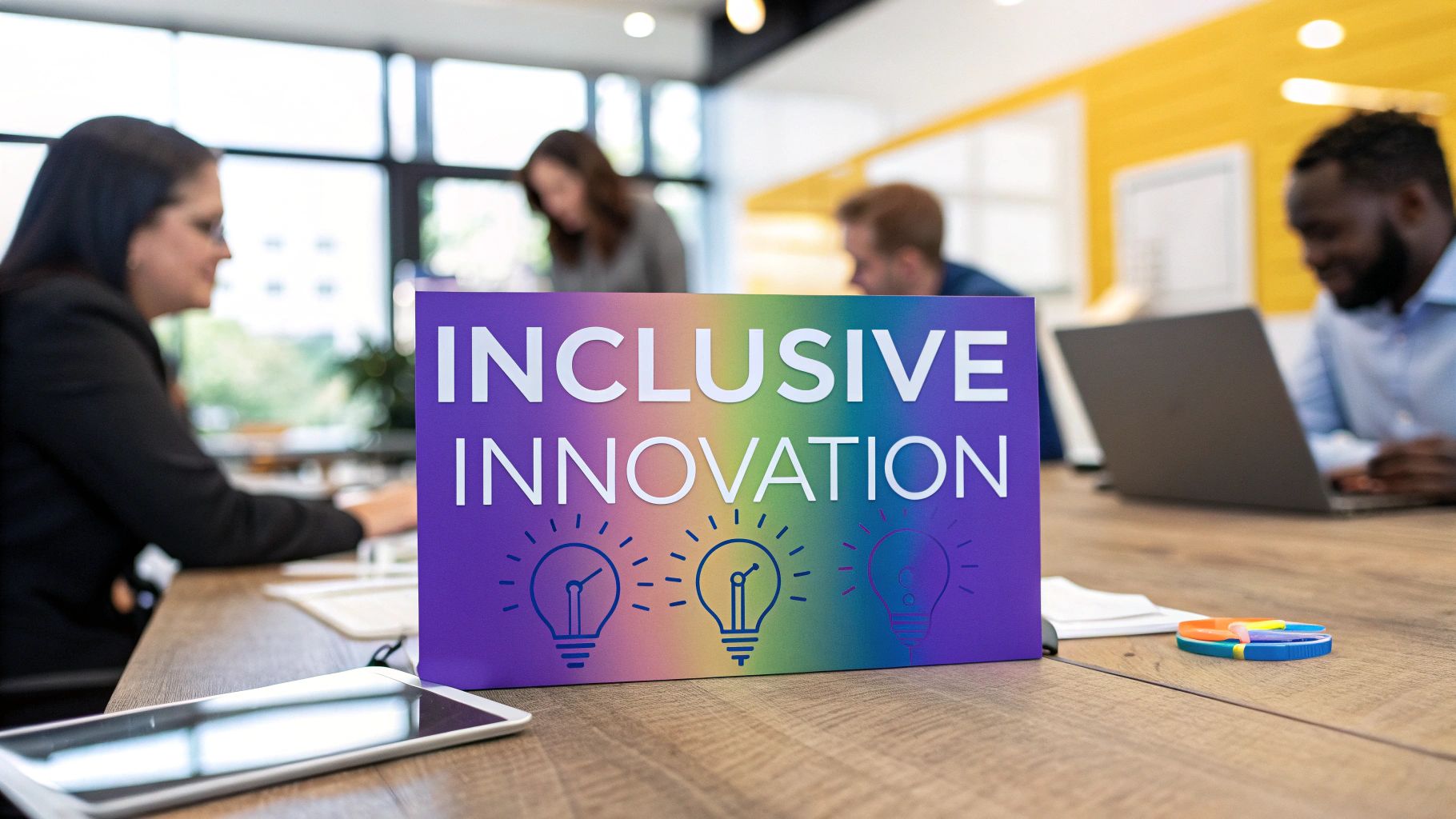Unconscious bias is the silent killer of great ideas. It's that gut feeling that makes us gravitate toward familiar concepts from people who look, think, and sound like us. This isn't about bad intentions; it's about how our brains are wired. But this automatic mental filtering can cause us to dismiss brilliant, game-changing ideas simply because they come from an unexpected source, quietly sabotaging a company's creative potential.
The Invisible Gatekeeper in Your Mind
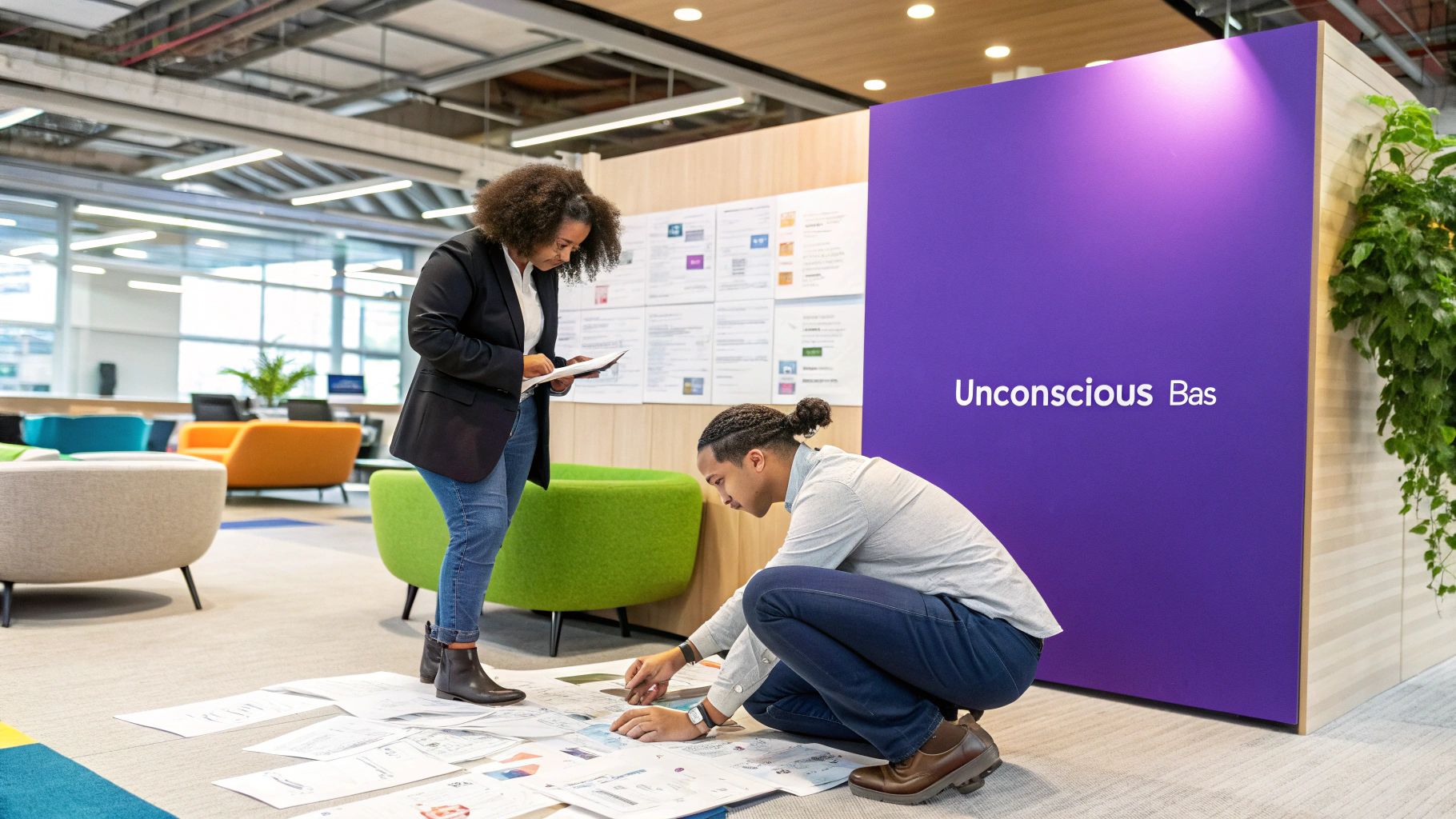
Think of your brain as a busy airport security checkpoint. It's constantly flooded with information. To keep things moving, it uses mental shortcuts—or biases—to quickly sort what feels safe and familiar from what seems new or different. This system is a lifesaver in our daily lives, but it becomes a huge roadblock when we're trying to innovate.
These automatic filters are what we call unconscious bias. They work behind the scenes, shaping our judgments without us even realizing it. In a creative setting, this invisible gatekeeper often stamps "rejected" on ideas that feel a bit weird, challenging, or simply come from someone we don't expect.
The Brain on Autopilot
So, why do our brains do this? It's a matter of survival. The human brain processes an incredible 11 million bits of information every single second. To handle that staggering amount of data (about 34 gigabytes a day, according to some estimates!), it has to make snap judgments. While this is great for quick decision-making, it can also reinforce stereotypes and shut out the very ideas that lead to real breakthroughs.
This is where inequality in innovation really starts. It’s not necessarily born from malice, but from a biological drive for efficiency that prefers the known over the unknown. The consequences, though, can be massive.
Key Takeaway: Unconscious bias isn't a personal flaw; it's a feature of how our brains work. The real challenge is to recognize its impact and create systems that stop it from deciding which ideas live or die.
How Bias Shapes Our Creative Choices
Unconscious bias shows up in a few common ways during the creative process, often causing teams to accidentally sideline their best thinking.
Here's what that looks like in practice:
- Favoring the Familiar: We're naturally drawn to ideas that fit our own experiences. An idea from someone with a similar background might just feel safer or more correct, even if a more original idea is on the table.
- Rewarding Confidence Over Competence: A slick, confident presentation can make a mediocre idea seem amazing. This is the "halo effect" in action, where our positive impression of the presenter bleeds over into our assessment of their concept.
- Seeking Agreement, Not Truth: It’s comfortable to agree. Teams often fall into the trap of confirmation bias, where they hunt for evidence to support a popular opinion instead of truly challenging it.
These subtle behaviors create a feedback loop where the loudest or most familiar voices get all the attention, while quieter, more diverse perspectives are ignored. This isn't just unfair—it puts a hard limit on a company's ability to innovate.
The table below breaks down how these subtle mental shortcuts create very real barriers to innovation.
How Bias Undermines Innovation
| Concept | Description | Impact on Creative Ideas |
|---|---|---|
| Confirmation Bias | The tendency to favor information that confirms pre-existing beliefs or ideas. | Teams rally around the "safest" or most popular idea, ignoring data that challenges it and missing better alternatives. |
| Halo Effect | Allowing a positive trait (like charisma) to positively influence your overall opinion of a person or their idea. | A weak idea from a charismatic presenter gets more attention and approval than a strong idea from a quieter team member. |
| Affinity Bias | The natural pull toward people who are similar to us in background, beliefs, or appearance. | Ideas from people "like us" are perceived as more valuable, while diverse perspectives are unconsciously devalued. |
Recognizing these patterns is the first step toward creating a truly level playing field for ideas. To go deeper, you can explore more about unlocking innovation with a diversity of ideas in our detailed guide.
How Unconscious Bias Influences the Selection of Ideas
Even with the best intentions, our brains are wired to favor the familiar. During the crucial selection phase—when a team decides which ideas to pursue and which to abandon—this tendency becomes a powerful, hidden obstacle. This is where unconscious bias in creative ideas inequality in innovation truly takes root, as cognitive shortcuts quietly steer us toward safer, more conventional choices while groundbreaking concepts are left behind.
These biases aren't just abstract theories; they are active in every meeting where ideas are evaluated. They create unwritten rules that determine which ideas are deemed "viable" and which are dismissed without a fair hearing. Understanding these mental traps is the first step to dismantling them and creating a process where the best idea wins, regardless of its origin.
The Pull of Affinity Bias in Decision-Making
We naturally gravitate toward people who remind us of ourselves. This is affinity bias, and it's devastating during idea selection. When a manager evaluates pitches, their personal connection to the presenter can unconsciously inflate the value of the idea.
Imagine two proposals are on the table. One comes from someone who shares the decision-maker’s background, communication style, or social circle. The other comes from someone with a completely different perspective.
Real-World Impact: Affinity bias can trick the leader into perceiving the idea from the similar person as more credible or strategically sound, not because of its merits, but because of the shared connection. A brilliant, disruptive idea from the "outsider" may be discarded simply because it doesn't come from a familiar source. This is how innovation becomes an echo chamber.
The Trap of Confirmation Bias When Choosing a Path
Our brains love being right. That's the core of confirmation bias: the tendency to seek out and favor information that supports our existing beliefs, while ignoring anything that contradicts them. During idea selection, this often means a team latches onto an early favorite and then spends the rest of the meeting defending it.
What does this look like?
- A team leader’s preferred idea is met with supportive comments, while critical questions are brushed aside.
- Data supporting the favored concept is highlighted, while conflicting data is labeled an "outlier."
- Concerns from skeptical team members are interpreted as "not being a team player."
This builds a dangerous consensus. A project gets the green light not because it’s the best option, but because the group successfully filtered out all dissenting opinions. The team ends up championing a flawed or mediocre idea, convinced they made a data-driven choice, when in reality, they just validated their initial hunch.
The Deception of the Halo Effect in Pitches
The halo effect occurs when our positive impression of a person—their charisma, confidence, or past successes—spills over and influences our judgment of their ideas. A polished, articulate presenter can cast a "halo" over their proposal, making a weak concept seem brilliant.
During a pitch session, the halo effect can cause decision-makers to focus more on the presenter's delivery than the idea's substance. A well-told story can feel more compelling than hard data. Meanwhile, a more reserved team member with a genuinely stronger, more innovative idea might be perceived as less convincing, and their idea is unfairly judged as weaker. The packaging becomes more important than the content, a classic example of unconscious bias in creative ideas inequality in innovation.
When Innovation Fails: The Real-World Cost of Bias
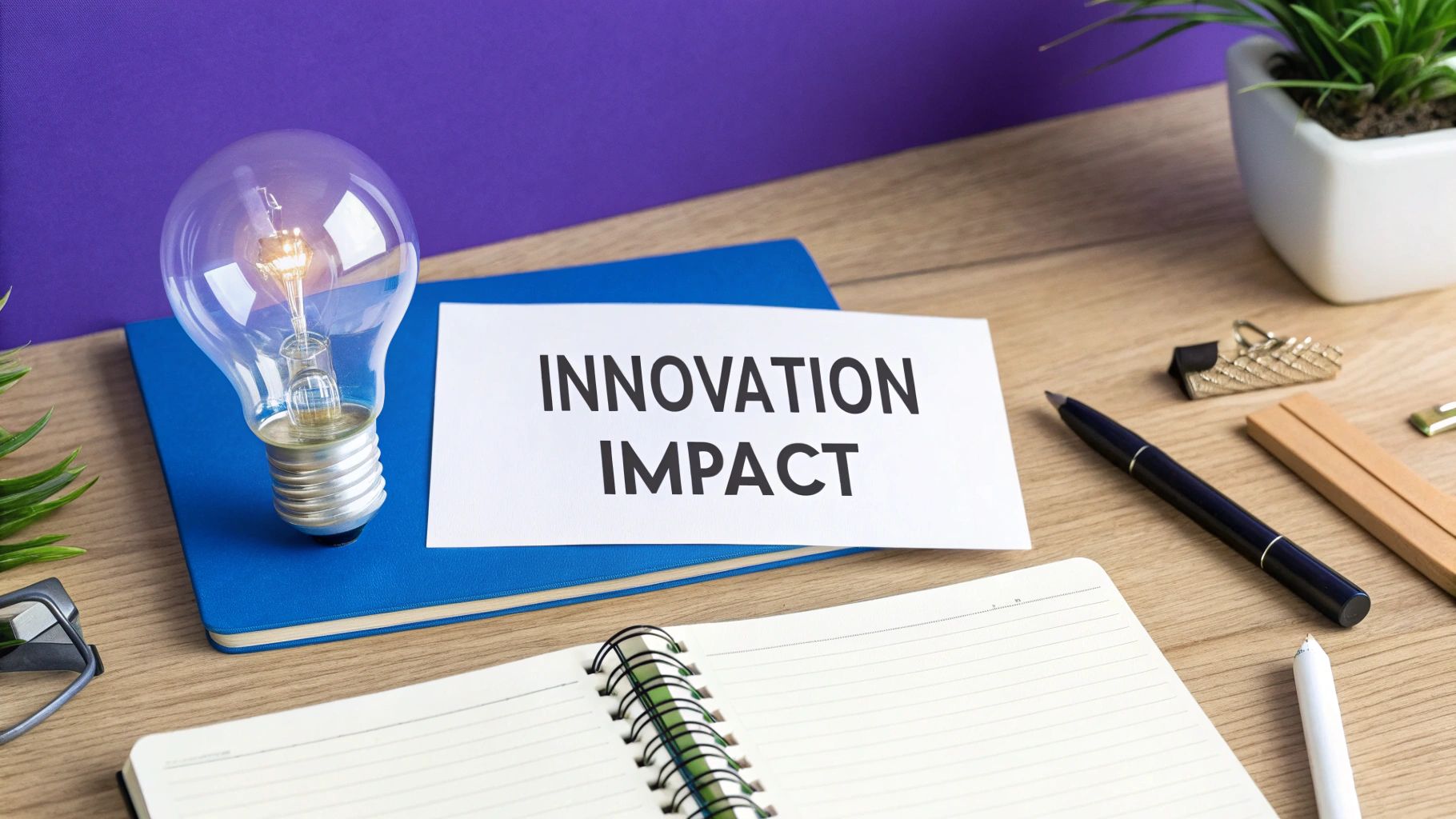
When teams let unconscious bias creep into their creative process, the fallout isn't just about hurt feelings or missed opportunities. It has real, tangible consequences. The inequality in innovation driven by this bias isn't some abstract concept—it’s a critical business flaw that leads to expensive, embarrassing, and sometimes downright dangerous outcomes.
On the surface, a failed product might look like a technical glitch or a marketing blunder. But if you dig a little deeper and trace it back to the drawing board, you’ll often find the root cause: a team of people who all looked and thought the same. They designed a solution for themselves, completely missing the mark for a much wider audience. These failures are powerful cautionary tales, proving that innovation without inclusion is simply incomplete.
Products Designed for a Fraction of the Population
Some of the most infamous examples of biased innovation come from teams that simply didn't think beyond their own small circle. This narrow perspective gets baked right into the final product, creating systems that exclude, frustrate, or even harm huge groups of people.
Take early voice recognition systems. For years, they were overwhelmingly trained using male voices. The result? Early voice assistants in cars and homes were notoriously bad at understanding commands from women. It wasn't a malicious plot to ignore female users; it was the direct outcome of a development team and a data set that lacked diversity.
This isn't a one-off problem. We've seen this pattern play out time and time again:
- Automotive Safety: For decades, crash test dummies were based on the average man's physique. This meant car safety features were optimized for men, leaving women 47% more likely to suffer serious injuries in a crash. The absence of female perspectives in the design and testing phases had life-threatening results.
- Medical Devices: Pulse oximeters, the little clips that measure your blood oxygen, have proven to be less accurate on darker skin tones. This flaw can lead to doctors missing critical conditions like hypoxia, all because the device wasn't tested on a truly diverse population.
These examples aren't just isolated incidents. They point to a systemic issue where the people in the room directly shape who a product works for—and who it fails.
Blind Spots That Damage Brands and Miss Markets
The tech world is full of stories about how unconscious bias creates products with massive blind spots. Facial recognition software has notoriously higher error rates when identifying women and people of color. In a classic blunder, Apple launched its HealthKit app with tons of metrics but completely forgot to include menstrual cycle tracking—a basic health marker for half the world's population. These oversights aren't just mistakes; they're symptoms of a team that lacked the diverse viewpoints needed to see the whole picture. If you're curious, you can find more insights about how the tech industry is tackling this.
The True Cost: When you innovate for a select few, you aren't just being exclusionary—you are actively walking away from enormous market opportunities. The price you pay, in both money and brand reputation, is staggering.
Product recalls, brutal headlines, and public backlash can permanently tarnish a company's image. But beyond that, these blunders represent billions in lost revenue from customer groups who feel ignored or alienated. Innovation inequality isn't just a social problem; it's a direct threat to your bottom line. When you fail to consider everyone at the very beginning, you're building failure into your product from day one.
The Hidden Drain on Your Company's Potential
Unconscious bias isn't just an HR buzzword or a social hurdle—it's a silent leak in your company's financial pipeline. Think about what happens when your sharpest minds feel their ideas are ignored, not based on merit, but because of who they are. The effect isn't just cultural; it hits the bottom line, hard. This isn't a "soft" problem. It's a business problem that chips away at your most valuable resource: your team's collective genius.
When people sense bias, a toxic cycle begins. A talented employee who feels consistently unheard or undervalued will, quite naturally, start to check out. Their creativity slows to a trickle, their drive fades, and eventually, they'll look for the door. The price of that turnover is steep, but the real damage starts much earlier. It starts the moment they decide their next brilliant idea simply isn't worth sharing.
Putting a Number on the Damage
The financial fallout from a biased workplace isn't just a theory; we can actually quantify it. When unconscious bias leads to inequality in innovation, it creates a massive roadblock to growth. For proof, look no further than the research: 34% of employees admitted to holding back ideas or solutions in the last six months because they felt the environment was biased.
That kind of self-censorship causes a quiet but devastating brain drain. Your team could be sitting on the next big thing, but if the room doesn't feel safe or fair, that idea will never surface. Now, imagine that effect multiplied across your entire organization. The lost potential is staggering. In fact, the total cost of workplace unconscious bias is estimated at a jaw-dropping $64 billion annually. That figure covers everything from turnover and lost productivity to legal fees. You can dig deeper into these findings by exploring the different faces of unconscious bias.
At the end of the day, it's not just about losing one person's idea. It's about losing the collaborative spark that ignites true breakthroughs.
The Domino Effect of Disengagement
Disengagement is the first and most immediate cost of an unfair system. Once people believe the game is rigged, they stop playing to win. This quiet quitting shows up in several expensive ways.
- Productivity Nosedives: Disengaged employees do the bare minimum. They show up, but their creative energy is gone, resulting in missed deadlines and subpar work.
- Absenteeism Creeps Up: A toxic or biased culture is mentally draining, leading to burnout and more sick days. This disrupts team momentum and overloads the colleagues who are still trying.
- Team Trust Evaporates: When some voices are consistently amplified while others are muted, trust dies. This fractures team dynamics and makes genuine, honest collaboration almost impossible.
The Hard Truth: A disengaged employee becomes a hidden cost center. They take up a seat and a salary but deliver only a fraction of their potential, all while dragging down the morale of everyone around them.
The High Price of Losing Your Best People
The final, and most expensive, consequence is watching your talent walk away. When smart, capable people from any background see their contributions repeatedly dismissed, they will eventually find a company that actually wants them. The cost of replacing an employee is no small matter—it’s often estimated at one-half to two times their annual salary.
Just think about the line items:
- Recruitment and advertising expenses
- Hours spent interviewing and screening candidates
- Onboarding and training costs for the new hire
- Lost productivity while the new person ramps up
This constant churn makes it incredibly difficult for teams to build deep institutional knowledge and real chemistry, a challenge that's even harder in a remote setup. That’s why creating a culture where every idea has a fighting chance is so important, and why many companies are working on fostering innovation in remote teams.
Ignoring bias isn't just bad for morale. It’s a broken business strategy that bleeds talent, suffocates creativity, and hands a massive advantage to your more inclusive competitors.
Building an Innovation Process That Outsmarts Bias
Knowing unconscious bias exists is one thing, but actually doing something about it is a whole different ballgame. To get a real handle on how unconscious bias creates inequality in innovation, you have to go beyond just good intentions and build a truly objective process. The aim is to create a system where ideas are judged fairly, not by someone's gut feeling, personal preference, or how familiar they seem.
This means rethinking how your team generates and chooses ideas from the ground up. Instead of a free-for-all where the loudest person or the senior manager wins, you build a framework that forces everyone to be objective. It’s about creating a system so strong that the best ideas just naturally float to the top, no matter who they came from.
This isn't just a hypothetical problem. The data below shows the very real impact of bias on innovation, highlighting huge gaps in patents, funding, and product launches when you compare diverse and non-diverse teams.
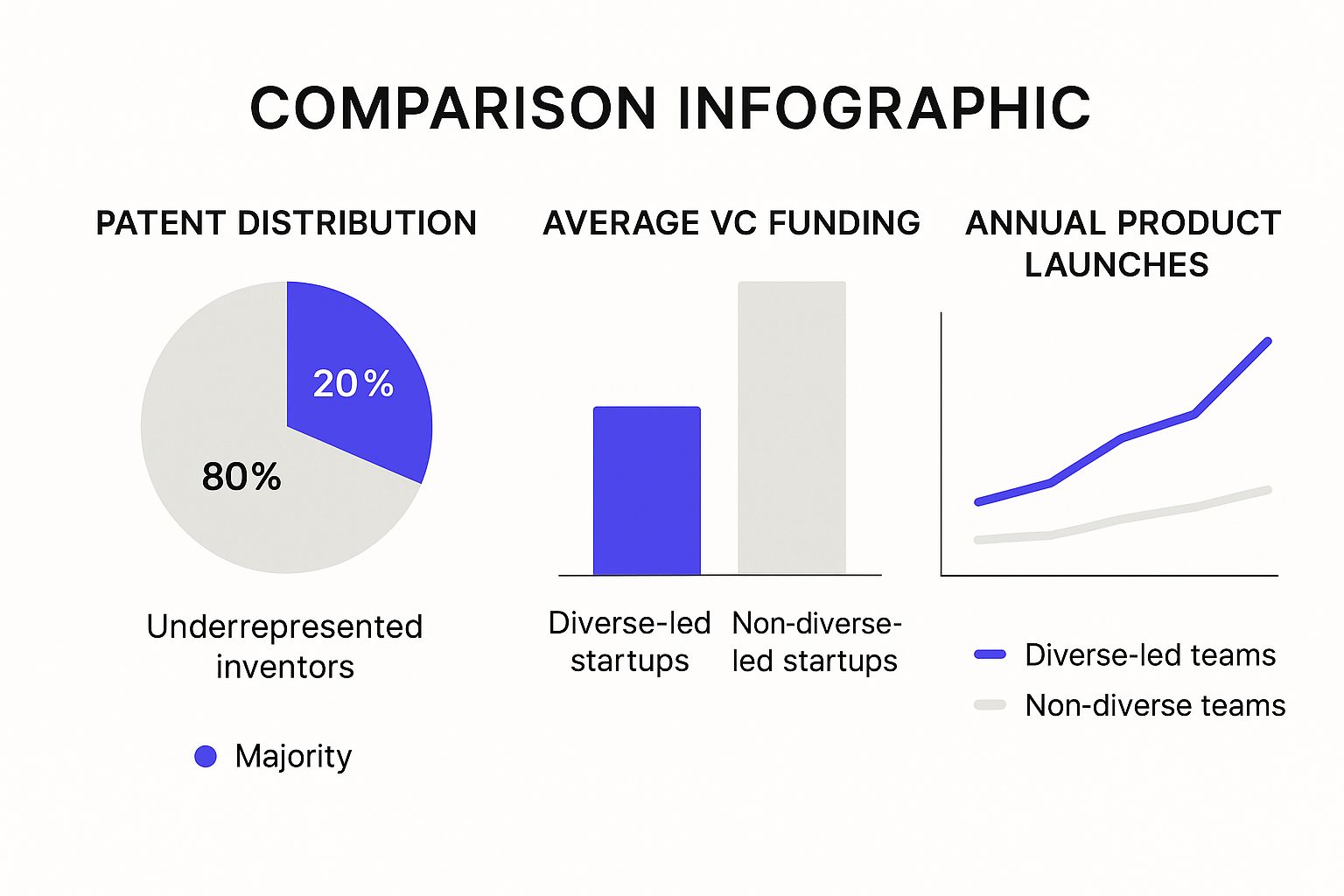
The numbers are clear: a lack of diversity in the innovation pipeline leads directly to measurable inequality in patents, funding, and overall market success.
From Open Brainstorms to Structured Systems
Let’s be honest—traditional brainstorming sessions are often a breeding ground for bias. The person with the most confidence, the highest-ranking title, or the best relationship with the boss can easily take over the conversation. When that happens, other valuable perspectives get pushed to the side, completely by accident.
A structured process, however, changes the entire dynamic. It introduces specific, clear steps designed to level the playing field for every single idea. This isn't about killing creativity; it's about giving every idea a fair fight.
One of the most powerful tools you can use is anonymity. When you separate an idea from the person who came up with it, biases like the halo effect just melt away. The concept has to stand on its own two feet, judged purely on its merits—not on the reputation or presentation skills of its author.
To see just how effective this can be, you can learn more about how to boost creativity with anonymous brainstorming and make your own sessions more equitable. By putting blind reviews in place, you make sure every idea starts on the same line.
Practical Tactics for a Bias-Resistant Process
Building a new process doesn't have to be a massive, complicated project. A few simple but powerful tactics can start systematically removing personal preferences from the equation.
Here are three core strategies you can implement right away:
- Standardized Evaluation Scorecards: Create a single set of criteria that every idea is measured against. This scorecard could include things like market potential, alignment with company goals, technical feasibility, and originality. This forces reviewers to think critically and objectively, moving beyond a vague "I just like it" feeling.
- Cross-Functional Review Panels: Instead of leaving big decisions to one manager or a team where everyone thinks alike, bring together a diverse group of reviewers. Get people from different departments, backgrounds, and levels of seniority. A person from finance will spot different things than an engineer, and that mix of perspectives is fantastic for catching blind spots.
- Delayed Judgment and Grouping: During the idea-generation phase, make one rule: no criticism allowed. The goal is simply to get as many ideas out as possible. Afterwards, you can group similar ideas together before evaluating them. This small step shifts the focus from an individual’s pitch to broader concepts, which reduces personal attachment and encourages people to build on the ideas together.
To make this crystal clear, the table below shows the difference between the old way of doing things and this more structured, fair approach. This comparison highlights how structured processes create a more equitable and effective environment for innovation.
Traditional Brainstorming vs Structured Idea Evaluation
| Feature | Traditional Brainstorming | Structured Idea Evaluation |
|---|---|---|
| Idea Submission | Ideas are shared openly, often attached to the person pitching them. | Ideas are submitted anonymously to remove personal bias. |
| Evaluation Method | Relies on subjective "gut feelings" and group consensus. | Uses standardized scorecards with objective criteria. |
| Decision-Makers | Often led by a single manager or the most dominant voices. | A diverse, cross-functional panel reviews all ideas equally. |
| Outcome | Favors ideas from charismatic, senior, or well-liked individuals. | The strongest ideas win based on merit, regardless of their source. |
By moving from a loose, open conversation to a disciplined framework, you create a process that actively pushes back against bias. If you're looking for more hands-on strategies, check out these 10 ways to overcome workplace biases. This is how you stop talking about fairness and start designing a true meritocracy for your team's best ideas.
Creating a Culture Where All Ideas Can Thrive
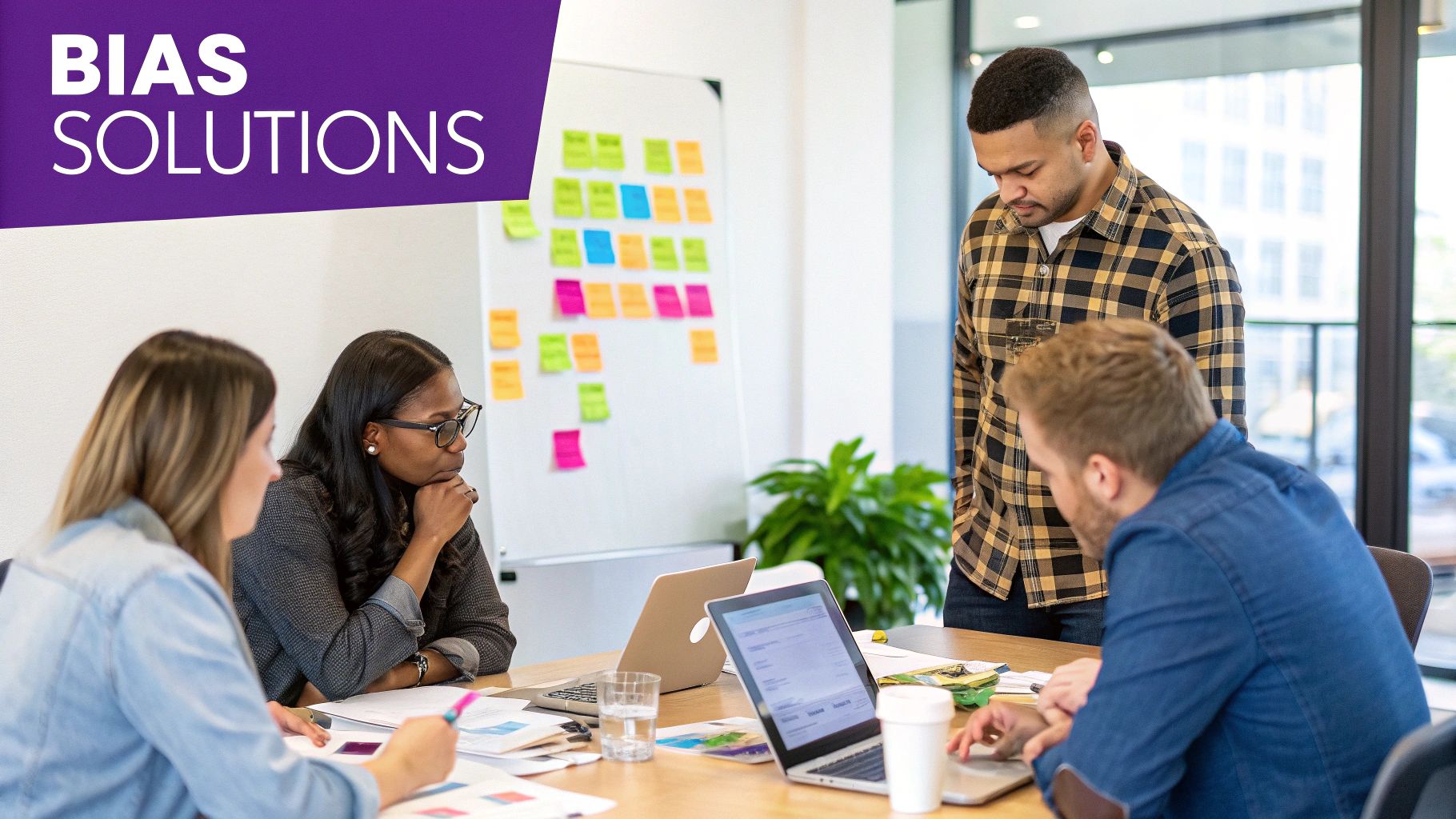
While structured tools and processes can level the playing field, they're only half the battle. The real secret to overcoming unconscious bias in creative ideas inequality in innovation is building a culture of psychological safety. It's about creating an environment where every team member feels confident enough to share their thoughts, question the way things are done, and even fail without facing punishment or ridicule.
This kind of culture doesn't just appear overnight. It has to be deliberately built and protected, starting right at the top. Leaders are the ones who set the tone, and their everyday actions will always carry more weight than a plaque on the wall.
The Essential Role of Leadership
Leaders need to be more than just managers—they must be active champions for every voice on their team. This isn't about passive support; it’s about modeling inclusive behavior in every interaction. When a leader goes out of their way to ask a quieter team member for their opinion or defends a new idea against the grain, it sends a clear and powerful signal to everyone.
This behavior establishes a new standard. It shows that creative input from all corners isn't just welcome, it's expected. These principles have to be woven into the company's DNA, influencing everything from how meetings are conducted to how performance is evaluated.
Key Insight: A psychologically safe culture isn't built in a single training session. It’s the cumulative result of thousands of small, consistent actions by leaders committed to making every voice count.
Embedding Inclusion into Daily Operations
To turn inclusive ideals into reality, you have to bake them into your company’s daily routines and systems. This is how you transform abstract goals into concrete actions.
Here are a few practical ways to get started:
- Inclusive Meetings: Make a point to ask for input from those who haven't spoken up yet. When someone gets interrupted, step in and make sure they can finish their thought.
- Fair Performance Reviews: Base evaluations on clear, objective criteria that are directly linked to an employee's role. It's also crucial to train managers to recognize and correct common biases, like being overly critical of female team members or undervaluing the work of junior staff.
- Company-Wide Communication: Use internal communications to celebrate a wide range of achievements and highlight contributions from different teams. This reinforces the core message that everyone's work is valuable.
A Call to Action for Equitable Innovation
Ultimately, fighting unconscious bias is a group effort. Leaders may set the tone, but every single person plays a part in creating a workplace where new ideas can flourish. You can become a champion for equitable innovation within your own circle. Advocate for an idea you believe in, listen with genuine curiosity, and be willing to question your own assumptions. As companies continue to explore how AI can help us be more creative, these human-led cultural shifts become even more vital.
To build an environment where all ideas can truly thrive, organizations also need to get a handle on their internal flow of information. By exploring proven knowledge management strategies, you can ensure that great insights don't get lost in the shuffle. When you combine smart processes with a deeply inclusive culture, you create a workplace where the best ideas win—regardless of who they came from.
Common Questions About Bias in Innovation
It’s one thing to understand what unconscious bias is, but it’s another thing entirely to see how it plays out in your daily work. You might be wondering, how does this really change my decisions? What can I even do about it?
Let's dig into some of the most common questions people have when connecting the dots between bias and creativity. The goal here is to give you straightforward, practical answers so you can start making a real difference.
Why Does My Gut Feeling Sometimes Lead Me Wrong?
That "gut feeling" you get? It's your brain running on autopilot. It uses mental shortcuts shaped by your past experiences to make snap judgments. While incredibly useful for survival, this is also where biases like the affinity bias and the halo effect thrive.
You might feel great about an idea just because it came from someone you click with or someone who presents with a ton of confidence. This doesn't mean your intuition is useless, but it's worth pausing to challenge it, especially when you're reviewing creative work. Just ask yourself: "Do I genuinely like this idea, or do I just like the person who pitched it?" That small moment of reflection can help you separate the concept from the person.
Isn't It Just About Hiring More Diverse People?
Hiring a diverse team is a crucial first step, but it’s not the whole story. If you bring brilliant, diverse minds into a system that’s still wired to reward the familiar, you haven't fixed the root issue. The inequality in innovation continues if those new voices are never truly heard.
True inclusion happens when every person in the room has their ideas considered with equal weight. Without fair, structured processes, even the most diverse teams can revert to old habits where just a few people dominate the conversation.
What’s One Simple Thing I Can Do to Reduce Bias?
If you want to do one thing right now, try this: build in a few minutes of silent, individual thinking before any group discussion. Give everyone five minutes to jot down their own ideas or feedback before anyone says a word.
This simple act stops the first or loudest person from setting the tone for the entire group. It gives introverted team members a real chance to contribute and encourages a much richer variety of thoughts. If you want to take it a step further, there are plenty of creative thinking exercises for teams designed to draw out everyone's best thinking. A few small, consistent habits can truly add up to create a more innovative and fair environment.
Ready to build an innovation process where every voice is heard and the best ideas win? Bulby provides structured, AI-guided brainstorming sessions that systematically reduce bias, enhance creativity, and unlock your team's full potential. Discover how to transform your creative collaboration at https://www.bulby.com.

